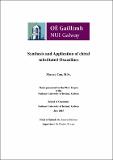Synthesis and application of chiral substituted oxazolines

View/
Date
2015-09-08Author
Zhenyu, Cao
Metadata
Show full item recordUsage
This item's downloads: 267 (view details)
Abstract
This thesis consists of two subprojects, dealing with the design, synthesis and application of novel (1) pyridinyl-oxazoline ligands and (2) prolyl-oxazoline ligands.
In Project 1 eleven novel pyridinyl-oxazoline ligands were synthesized. Metal complexes of these ligands have been applied to transition-metal catalysed reactions, including asymmetric cyclopropanation reaction, asymmetric allylic alkylation reaction and asymmetric reduction of a conjugated ketone. The copper complexes of these ligands gave good conversions (up to 73%) but low enantiomeric excesses (up to 14%) in the cyclopropanation reaction. In the allylic alkylation reaction, the palladium complexes of these ligands showed excellent activities (up to 96% conversion) and modest selectivities (up to 28% ee). In the asymmetric reduction of a conjugated ketone, up to 99% conversions and 20% ee were achieved using the cobalt complexes of these ligands..
The ligands were also applied to the organo-catalytic reactions, including the trichlorosilane-assisted hydrosilylation of acetophenone and an imine, and the allyltrichlorosilane-assisted allylation of benzaldehyde. In the hydrosilylation the ligands showed outstanding catalytic activities giving over 90% conversions in 13 out of the 17 test reactions. In the hydrosilylation of an imine the ligands gave up to 28% ee and in the hydrosilylation of acetophenone the ligands offered up to 70% ee, the highest seen in our work in this reaction. In the allylation of benzaldehyde the ligands were not as efficient, giving up to 11% conversion and 25% ee.
In Project 2, we designed and developed two pathways for the synthesis of a prolyl oxazoline ligand. We then attempted the synthesis of a phosphine- oxazoline ligand from this prolyl oxazoline base. Although the synthesis was not completed, due to time constraints, it demonstrated the potential of synthesizing a novel phosphine-oxazoline ligand in a flexible manner via two synthetic routes.
Chapter One deals with the introduction of general concepts of asymmetric synthesis, oxazoline ligands and their applications to different catalytic reactions. Chapter Two discusses the synthesis of novel mono-oxazoline ligands and the application of these ligands, or the metal complexes of these ligands, to the asymmetric catalytic reactions. Chapter Three contains the full experimental details for the project, including spectral and analytical data.

